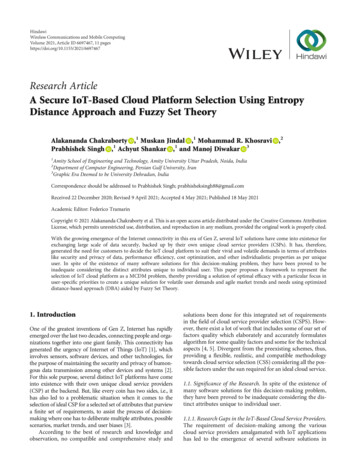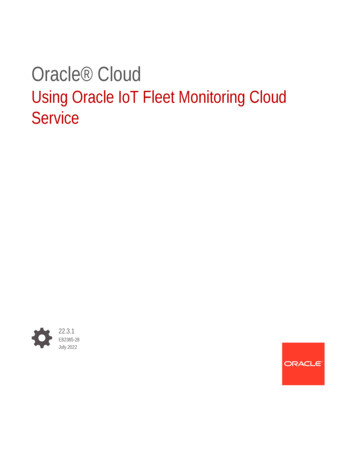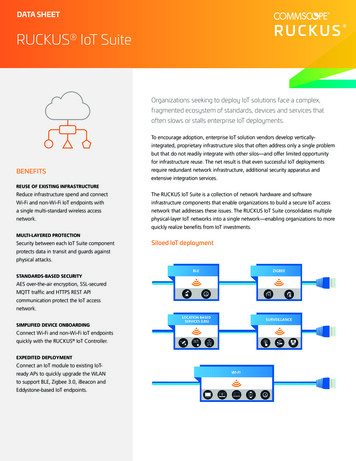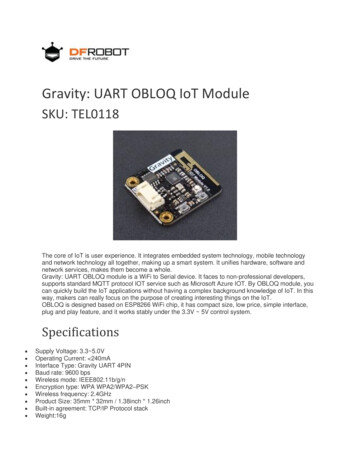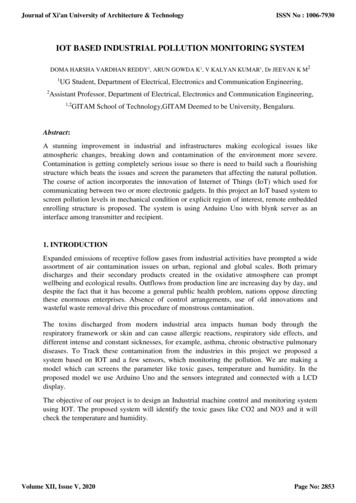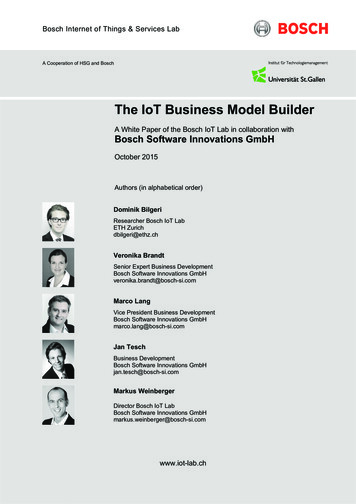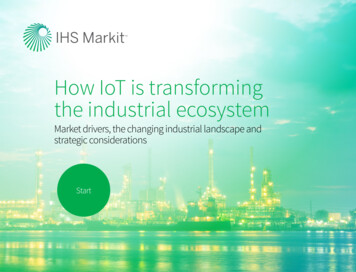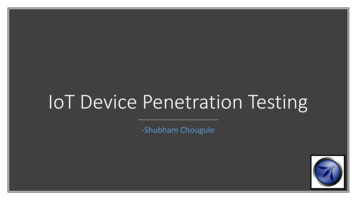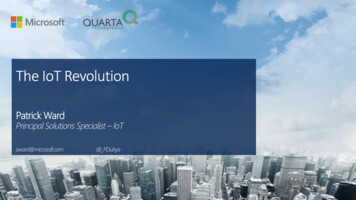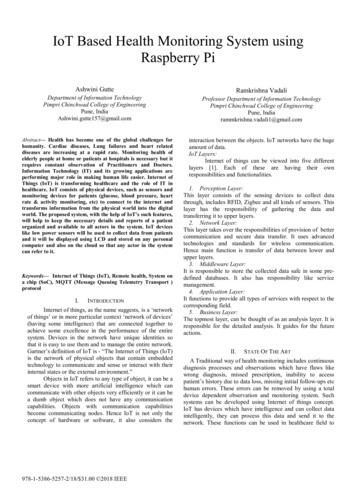
Transcription
IoT Based Health Monitoring System usingRaspberry PiAshwini GutteRamkrishna VadaliDepartment of Information TechnologyPimpri Chinchwad College of EngineeringPune, IndiaAshwini.gutte157@gmail.comProfessor Department of Information TechnologyPimpri Chinchwad College of EngineeringPune, Indiarammkrishna.vadali1@gmail.comAbstract— Health has become one of the global challenges forhumanity. Cardiac diseases, Lung failures and heart relateddiseases are increasing at a rapid rate. Monitoring health ofelderly people at home or patients at hospitals is necessary but itrequires constant observation of Practitioners and Doctors.Information Technology (IT) and its growing applications areperforming major role in making human life easier. Internet ofThings (IoT) is transforming healthcare and the role of IT inhealthcare. IoT consists of physical devices, such as sensors andmonitoring devices for patients (glucose, blood pressure, heartrate & activity monitoring, etc) to connect to the internet andtransforms information from the physical world into the digitalworld. The proposed system, with the help of IoT’s such features,will help to keep the necessary details and reports of a patientorganized and available to all actors in the system. IoT deviceslike low power sensors will be used to collect data from patientsand it will be displayed using LCD and stored on any personalcomputer and also on the cloud so that any actor in the systemcan refer to it.Keywords— Internet of Things (IoT), Remote health, System ona chip (SoC), MQTT (Message Queuing Telemetry Transport )protocolI.INTRODUCTIONInternet of things, as the name suggests, is a ‘networkof things’ or in more particular context ‘network of devices’(having some intelligence) that are connected together toachieve some excellence in the performance of the entiresystem. Devices in the network have unique identities sothat it is easy to use them and to manage the entire network.Gartner’s definition of IoT is - “The Internet of Things (IoT)is the network of physical objects that contain embeddedtechnology to communicate and sense or interact with theirinternal states or the external environment.”Objects in IoT refers to any type of object, it can be asmart device with more artificial intelligence which cancommunicate with other objects very efficiently or it can bea dumb object which does not have any communicationcapabilities. Objects with communication capabilitiesbecome communicating nodes. Hence IoT is not only theconcept of hardware or software, it also considers the978-1-5386-5257-2/18/ 31.00 2018 IEEEinteraction between the objects. IoT networks have the hugeamount of data.IoT Layers:Internet of things can be viewed into five differentlayers [1]. Each of these are having their ownresponsibilities and functionalities.1. Perception Layer:This layer consists of the sensing devices to collect datathrough, includes RFID, Zigbee and all kinds of sensors. Thislayer has the responsibility of gathering the data andtransferring it to upper layers.2. Network Layer:This layer takes over the responsibilities of provision of bettercommunication and secure data transfer. It uses advancedtechnologies and standards for wireless communication.Hence main function is transfer of data between lower andupper layers.3. Middleware Layer:It is responsible to store the collected data safe in some predefined databases. It also has responsibility like servicemanagement.4. Application Layer:It functions to provide all types of services with respect to thecorresponding field.5. Business Layer:The topmost layer, can be thought of as an analysis layer. It isresponsible for the detailed analysis. It guides for the futureactions.II.STATE OF THE ARTA Traditional way of health monitoring includes continuousdiagnosis processes and observations which have flaws likewrong diagnosis, missed prescription, inability to accesspatient’s history due to data loss, missing initial follow-ups etchuman errors. These errors can be removed by using a totaldevice dependent observation and monitoring system. Suchsystems can be developed using Internet of things concept.IoT has devices which have intelligence and can collect dataintelligently, they can process this data and send it to thenetwork. These functions can be used in healthcare field to
collect patient’s data on local and also send it to remotemachines. The data collected can be processed and sent toother nodes. Abilities of IoT networks can be used to monitorthe health of a patient by periodically analyzing the datacollected. Hence Healthcare application of IoT involves threemajor functions:a) Tracking an object or patientb) Identification and authenticationc) Sensing and Data collectionsystem. Hence this system works on the basic client-serverprinciple of computer networking. Data collected on the IoTserver is stored for the reference of all peers in the systemand transmitted to these peers as and when required.C. Proposed System ArchitectureBasic Blocks:Data collection here refers to the collection ofhealth parameters like temperature, Blood Pressure,Heartbeat rate, ECG parameters etcIII.PROPOSED SYSTEMThe proposed system aims to Monitor Health ofelderly people using IoT devices and store the collected dataon the IoT server.A. Objective of the Work To Provide technological support to make healthcaresystems easier and faster To Collect accurate physical parameters of a patient To Provide availability of necessary data on theinternet To Provide faster assessment and treatmentB. Proposed System ApproachAn The work flow of the proposed system consists offour stages- Data acquisition, Data Processing, Data Storageand Data Transmission.Fig 1: Work-flow of the proposed systemAs per the workflow first task in the system is to collectdata from patients through the sensors. Data here refers tothe health parameters of temperature and heartbeat-rate. Thesensors used in such systems are low power sensors. Theycollect data from patient on timely basis. With thisfrequently obtained data the health condition of particularpatient is observed and required prescriptions arerecommended. This collected data is shown on a LCDdisplay connected to the raspberry pi board, if required thatdata is processed and then forwarded to IoT server forstorage from where it is accessible to desired clients in theFig 2: Basic Blocks of the systemThe proposed system basically consists of three main blocksas shown in figure 3. One block consists of the raspberry pi3 model b in which wireless connectivity is provided withinthe kit itself and does not need external wifi module. Thedata is collected at this side and is sent to IoT server. IoTserver is the data storage of overall system. That data isaccessible at the doctor’s side so they can access thisinformation of patients and provide necessary prescription.System Architecture:Fig 3. Proposed System ArchitectureAs shown in the proposed system architecture, the data frompatient is collected at the raspberry pi with the help ofsensors. The data collected will be stored onto the IoTserver as per patient-ids and then forwarded to Doctor foranalysis. The Doctor will analyze this data and will giveassessment accordingly and hence monitoring of health isdone. The protocol used for data transfer andcommunication is HTTP. Generally used protocols with IoTbased systems are CoAP , MQTT and HTTP. CoAP is usedwhere network performance is the main target to achievewhile HTTP and MQTT are chosen for sensor based2018 Fourth International Conference on Computing communication Control and Automation (ICCUBEA)
applications and according to the application’s requirement.D. Implementation:set for this sensor is 200 ms (PR interval) if found valuebeyond than that alarm is generated.Circuit connections of the System:Devices used:1. Raspberry piThe Raspberry Pi is a credit-card sized small and cheapcomputer that plugs into a computer monitor or TV, and uses astandard keyboard and mouse. It is a capable little device thatenables people of all ages to explore computing, and to learnhow to program in languages like Scratch and Python. It’scapable of doing everything you’d expect a desktop computerto do, from browsing the internet and playing high-definitionvideo, to making spreadsheets, word-processing, and playinggames. [7]Several generations of Raspberry Pis have been released. Allmodels feature a Broadcom system on a chip (SoC) with anintegrated ARM compatible central processing unit (CPU)and on-chip graphics processing unit (GPU). Raspberry Pi 3Model B was released in February 2016 and has onboard WiFi, Bluetooth and USB boot capabilities. By 2017, itbecame the newest mainline Raspberry Pi. On 28 February2017, the Raspberry Pi Zero W was launched.[8]The proposed system uses Raspberry pi 3 model B. Data iscollected from the sensors which are connected to thisraspberry pi board. Sensors used are temperature sensor,heartbeat sensor and ECG sensor which are described in thesucceeding sections. The data from these sensors is displayedon the LCD display and is sent to the IoT server. And it isaccessible to desired ones. Patients’ data is collected fromthese sensors and it is provided to doctors and healthprofessionals. The analysis should be given back to patientsfrom the data provided.2.Temperature sensor:Fig 4: Circuit of the systemUser Login for data access:Fig 5: Login PageDatabase on the server:Temperature sensors are of different types. The proposedsystem uses the LM35 temperature sensor. It is an analogsensor but provides correct readings as desired by theapplication.3.Pulse-Rate Sensor:Pulse rate sensor is used for checking the pulse-rate. The pulserate up to 88-90 is considerable beyond that range it is notacceptable and considered as a danger so an alert will begenerated for such cases. The sensor used is an analog sensorand needs an Analog to Digital converter as raspberry pi doesnot take analog inputs.4.ECG Sensor:Fig 6: Data Storage on the IoT severE. Results:Electrocardiogram sensor is used for ECG monitoring. ECGprovides more information about the heart-beat rate and allother disease indications. Hence monitoring the help will bemore useful with the help of this sensor. The threshold valueAlert Notifications:This system sends sms and email alerts to the targetedusers (Doctors/ Health professionals)of the system if2018 Fourth International Conference on Computing communication Control and Automation (ICCUBEA)
particular sensor value is beyond the decided range,threshold value so that user will be aware of the health andcan take care accordingly.he/she sends precaution notification and instructions about thediet to the patient.Fig 9: Precaution notification via smsIV.Fig 7: Sms AlertCONCLUSIONA health monitoring system based on concept of internet ofthings with implementation of it on raspberry pi is proposed. Itfollows the basic MQTT protocol of IoT and it is anapplication of remote health monitoring. It helps for betterdiagnosis of the patients with chronic diseases. This systemhelps to monitor health of elderly people who cannot visit thehospitals on regular basis. Hence Primary health checkups arealso made easy. Patients’ history is saved on the server henceit benefits the follow-ups. As it uses information technologyfor the assessment human errors are removed hence givesbetter performance.REFERNCES[1]Fig 8: Email AlertDecision Making of Health condition(on Doctor’s side):No. of sms/email alertsAlerts 3Alerts 3[2]Health Status of a PatientUnhealthyCriticalTable 1: Health Status PredictionsSending Precaution Notification from Doctor to Patient:In case of emergencies that is in case of sensor valuescrossing the threshold values doctor gets the alert sms andfrom that he/she will be able to know about the health status ofthe patient and can take further decisions. If found urgent[3]Tan, Lu, and Neng Wang. "Future internet: Theinternet of things." 2010 3rd InternationalConference on Advanced Computer Theory andEngineering (ICACTE).Vol. 5.IEEE, 2010.Jorge Gomez , Byron Oviedo , Emilio Zhuma,“Patient Monitoring System Based on Internet ofThings ” , The 7th International Conference onAmbientSystems,Networks andTechnologies, 1877-0509 2016, ElsevierK. Natarajan , B. Prasath , P. Kokila , ”SmartHealth Care System Using Internet of Things”,Journal of Network Communications andEmerging Technologies (JNCET), 2016, JNCET.2018 Fourth International Conference on Computing communication Control and Automation (ICCUBEA)
[4] Chetan T. Kasundra , Prof. A. S. Shirsat ,“Raspberry PI Based Health Monitoring System”,International journal of Advanced Research inElectrical, Electronics and 0408083,IJAREEIE[5] VikasVippalapalli , SnigdhaAnanthula , “Internetof Things (IoT) based smart health Care System”CENTERIS 2014 - Conference on ENTERpriseInformation Systems, Elsevier Inc[6] SapnaTyagi , AmitAgarwal , PiyushMaheshwari“A Conceptual Framework for IoT BasedHealthcare System using Cloud Computing” , 9781-4673-8203-8/16/ 31.00 c 2016, IEEE[7] https://www.raspberrypi.org[8] https://en.wikipedisa.org/wiki/Raspberry Pi2018 Fourth International Conference on Computing communication Control and Automation (ICCUBEA)
and on-chip graphics processing unit (GPU). Raspberry Pi 3 Model B was released in February 2016 and has on-board WiFi, Bluetooth and USB boot capabilities. By 2017, it became the newest mainline Raspberry Pi. On 28 February 2017, the Raspberry Pi Zero W was launched.[8] The proposed system uses Raspberry pi 3 model B. Data is
